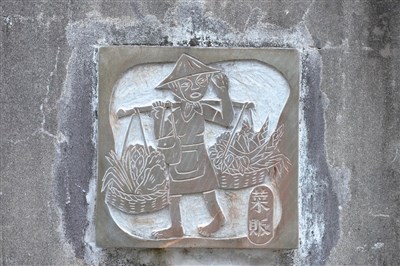 圖/莊坤儒
宜蘭舊城百工樣態經過匠師巧手燒磚成畫,傳承百年技藝。
圖/莊坤儒
宜蘭舊城百工樣態經過匠師巧手燒磚成畫,傳承百年技藝。
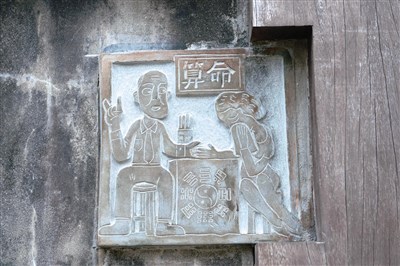 圖/莊坤儒
宜蘭舊城百工樣態經過匠師巧手燒磚成畫,傳承百年技藝。
圖/莊坤儒
宜蘭舊城百工樣態經過匠師巧手燒磚成畫,傳承百年技藝。
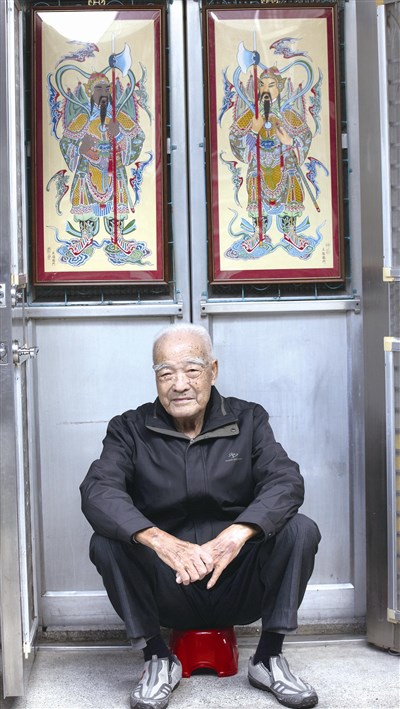 一代匠師曾水源為了社區重提畫筆,傳承四代的彩繪巧藝,是最珍貴的無形資產。(張素卿攝)
一代匠師曾水源為了社區重提畫筆,傳承四代的彩繪巧藝,是最珍貴的無形資產。(張素卿攝)
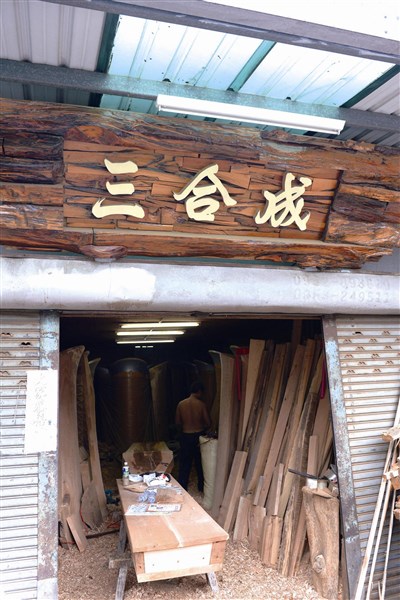 鄂王社區推動「匠師博物館」計畫,替老匠師工作坊打造新門面,讓遊客按圖索驥輕鬆尋訪。圖/莊坤儒
鄂王社區推動「匠師博物館」計畫,替老匠師工作坊打造新門面,讓遊客按圖索驥輕鬆尋訪。圖/莊坤儒
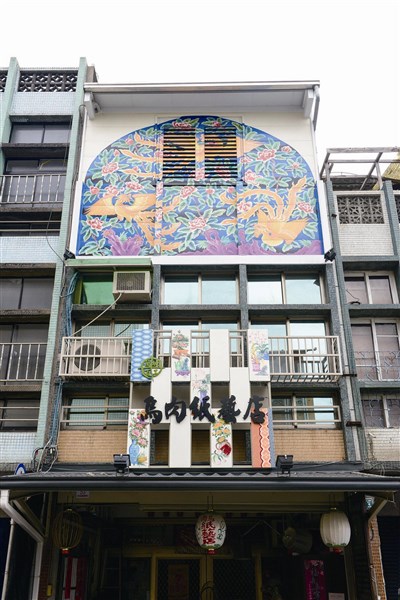 鄂王社區推動「匠師博物館」計畫,替老匠師工作坊打造新門面,讓遊客按圖索驥輕鬆尋訪。圖/莊坤儒
鄂王社區推動「匠師博物館」計畫,替老匠師工作坊打造新門面,讓遊客按圖索驥輕鬆尋訪。圖/莊坤儒
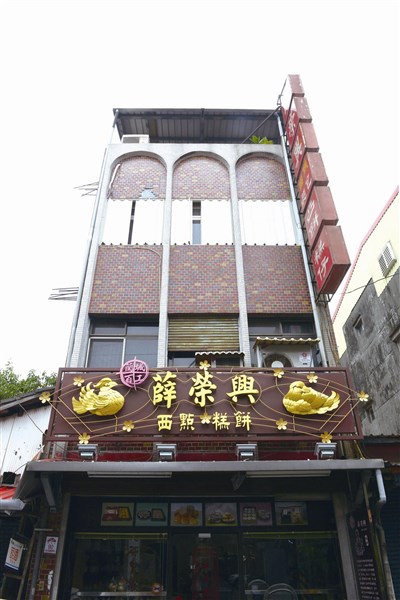 鄂王社區推動「匠師博物館」計畫,替老匠師工作坊打造新門面,讓遊客按圖索驥輕鬆尋訪。圖/莊坤儒
鄂王社區推動「匠師博物館」計畫,替老匠師工作坊打造新門面,讓遊客按圖索驥輕鬆尋訪。圖/莊坤儒
提 要
民國一○二年,在福建廈門舉行的國際宜居社區大獎頒獎典禮上,台灣宜蘭的鄂王社區,得到非常特別的「藝術文化保存模範獎」,這個獎項獨立於其他綜合評比項目,特別推崇鄂王社區在傳統工藝及文化保存上的努力,讓這個只有八百多人的小小社區,在國際上大大發光。社區靠自發的凝聚力,讓傳承二百年的工匠技藝,從沒落到復興。
Lin Ming-hsin, the community's borough chief since 2003, is also president of the E-Wang Community Development Association. He observes that a decade ago "E-Wang was the grungiest part of Yilan." In stark contrast to bustling nearby streets, it was littered with broken-down old homes and mounds of trash, and attracted homeless people who used to relieve themselves wherever they felt the urge.
In the years since, the community's environmental protection efforts have made it a model for the nation. Now pristine, it has won an International Awards for Liveable Communities bronze medal in Category A (communities with fewer than 20,000 people). Lin says that the turnaround has been a grassroots effort.
At the first community development meeting, a local senior citizen mentioned a professor at National Chang hua University of Education who was from E-Wang and well versed in both painting and installation art. The senior suggested that this professor might be able to help them create a strategy.
The professor in question was Chen Shih chiang, an associate professor in NCUE's Department of Art who had attended graduate school at New York University and had also organized a number of exhibitions of installation art in central and southern Taiwan. When Lin approached him for advice, Chen immediately agreed to help out.
"I painted pictures of temples, festivals and street scenes here back when I was in elementary school," recalls Chen. "I was fated to return." He says that while the temples and food vendors he painted as a child still exist, the woodworking and painting studios that used to line the streets have gone. Having seen the changes, he appreciates the cultural assets that remain all the more.
When Chen returned, he began working with the development association to restore the community's 200-year-old well. The project removed trash and rubble from around the well, reusing some of the rocks and bottles to repave and decorate the surrounding area, and got the well back into working order. "Locals used to draw their water here when I was a boy. We relied on it to wash our clothes, cook food, and make tea. Once we got tap water, people began neglecting the well, and even dumping garbage around it. With the trash and the stink, residents stopped wanting to go anywhere near it." Lin says that they filled two trucks with trash they cleared from the area, and that locals cheered when the well reappeared.
In early 2014, an exhibition of mural paintings was held at the Yang Shi-fang Memorial Garden in E-Wang Community. Tseng Shui-yuan, a mural painter who retired more than 20 years ago, picked up his brushes again to create The Four Heavenly Kings for the show. Tseng also permitted the exhibition of a generations-old family collection of working sketches in hope that it would lead society to appreciate the value of this fading art form.
With a strategy to work from, the community set about finding local artisans and discovered a large number of "hidden dragons", including tile painters, lacquer artists, wood carvers, embroiderers, and paper-flower makers.
In 2013, the county government invited Lin and his community partners to assemble all the information they had gathered over the years into a booklet, and submit it to the International Awards for Liveable Communities. The effort not only earned a bronze medal in Category A, but also a Criteria Award for Arts, Culture and Heritage.
Having seen both good times and bad, E-Wang is now sharing its traditional arts with a new generation and marching into the future with its head held high.
翻 譯
一○二年當選里長的鄂王社區發展協會理事長林銘信,對比鄂王社區今昔面貌有感而發:「十年前,這個社區是宜蘭最髒亂的角落。」這裡以前到處都是破敗的老屋,堆滿垃圾,遊民聚集,隨地便溺,跟附近熱鬧的街道形成強烈對比。
十年後的今天,鄂王社區不但成為全國環境保護模範社區,環境清潔特優社區,還拿下宜居社區銅質獎,林銘信說,社區居民的力量是關鍵。
彰化師範大學美術系副教授陳世強是關鍵人物,他曾留學美國紐約大學藝術研究所,並在中南部舉辦過多場裝置藝術展,當林銘信帶著社區資料求見時,他一口答應回鄉助陣。
「我還在念小學的時候就畫了這裡的廟宇、街景、節慶,當時就注定我日後要回來社區吧。」陳世強說,拿出小時候的畫作對比,昭應宮、城隍廟仍在,小吃攤也沒變,但是以前滿街的木工坊、彩繪坊都凋零了。顧望滄海桑田,他更珍惜現在存續的文化資產。
返鄉後,陳世強首先與社區發展協會合力推動「搶救古井」計畫,將社區裡一口兩百多年歷史的荒廢古井重新整理,清出來的瓦礫、石塊、酒瓶,則重新利用,化身為古井周圍的裝飾品和石子路。「小時候村民都在這裡取水,洗衣、泡茶、煮飯都靠這口井;後來有了自來水,古井逐漸荒廢,堆滿垃圾,又髒又臭,根本沒人想靠近。」林銘信說,那天清出來兩台卡車的垃圾,終於看見井水時,村民都興奮歡呼。
一○三年初,在鄂王社區內的楊士芳紀念林園舉辦了一場彩繪作品展,已經封筆二十多年的彩繪師傅曾水源,重新執筆,發表巨幅手繪《四大金剛》,此外他更毫不藏私地將祖傳工作手稿悉數展出,盼望社會能更加重視彩繪這門日漸凋零的老技術。
水源師在六十歲那年決定不再畫廟,「以前寺廟一蓋就是二、三十年,畫師可以一展長才,充分發揮,後來都變成用照相、電腦繪圖複製,老技術沒人要了,乾脆不畫。」心灰意冷之際,他改以畫筆記錄宜蘭建築與百工雜技,手繪圖鑑,為歷史留紀錄。百年傳承的彩繪技術,幾乎就要失傳。
直到一○二年,鄂王社區發展協會著手調查社區內資源,才又發掘出這位人間國寶。「老師傅說,我們那些東西『沒效啊啦』!」林銘信說,當初找上這些老師傅,他們對自己擱下多年的技術幾乎已失去自信,「我們研究社區歷史,才發現這些老人家一個個都是寶藏。」在林銘信連番請託之下,終於才說動水源師重拾畫筆,開辦畫展,並大力協助社區內的空間改造,指導子姪輩參與閒置牆面彩繪,讓老技藝重見天光。
「我養八個孩子,全靠彩繪,這是祖先傳下來的吃飯手藝,不能放棄,」水源師驕傲地說。曾家彩繪從祖輩傳承下來,高齡八十九歲的曾水源是第三代,兒子、姪子則是第四代傳人,已被登錄為宜蘭縣無形文化資產。
有了領頭示範,社區內的眾多匠師資源也陸續被挖掘出來,磁磚彩繪、漆藝、木刻、刺繡、紙花等老師傅,紛紛站出來,讓居民驚嘆,原來社區臥虎藏龍,能人輩出。
社區逐漸做出成果後,民國九十九年他們以楊士芳紀念林園為社區中心,連年舉辦手作工藝展覽,一○一年起,他們更推動「匠師博物館」計畫,替老匠師重新設計、裝潢現有的工作空間與門面,並製作蘭城百工地圖,遊客只要按圖索驥,便能拜訪藏身街坊裡的匠師們,一窺堂奧。
一○二年,在宜蘭縣政府邀請下,他與社區夥伴將歷年來的成果整理成冊,報名參加國際宜居社區大獎評比,不但奪得A組(二萬人以下社區)銅質獎,更拿下跨組別的藝術文化保存模範獎,在國際上大出風頭。
在工業化、大量生產的時代,手工巧匠曾被棄如敝屣;而在老師傅們凋零前,竟又意外興起一波崇尚手作、古法的熱潮,讓這些珍貴的手工藝再現風采,甚至揚名國際。
走過興衰動盪,鄂王社區如今要帶著榮耀與驕傲,繼續他們承先啟後,傳藝百年的使命。
文/陳建瑋 圖/莊坤儒
摘錄轉載自103年12月《台灣光華雜誌》
全文請參考
http://www.taiwan-panorama.com/